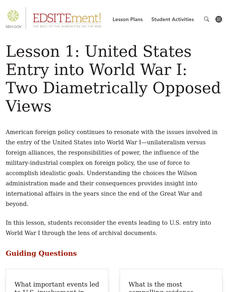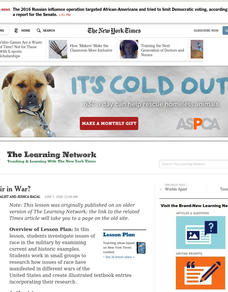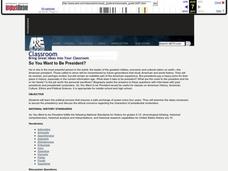Curated OER
Preservation of Civil War Battlefields
Eighth graders examine the importance of battlefield preservation. In this US History lesson, 8th graders participate in a virtual tour of battle sites. Students create a map of Gettysburg to see the topography of the battle...
Curated OER
Portraits of the Presidents
Learners study the United States Presidents through a variety of activities, games, and puzzles. In this United States President lesson plan, students are introduced to the Presidents and the role the president has played throughout...
Curated OER
Korematsu v. United States (1944)
High schoolers examine equal protection. In this Supreme Court lesson, students examine primary documents from Korematsu v. United States and discuss the implications of the decision with regards to Japanese internment.
Curated OER
Happy Endings: The Final Battle
Fifth graders explore all the myths of the battle of Yorktown. A variety of primary documents are viewed and analyzed for discussion. They become aware that what one sees and hears is not always as it seems in reality. Each group...
Curated OER
Planting Seeds of Philanthropy
Middle schoolers explore the importance of maintaining a democracy through philanthropic actions. In this character education lesson, students discover what the Japanese internment camps were, and why they were an infringement on...
Curated OER
Navajo Code Talkers
Students investigate the Navajo Code Talkers and their role in World War II. They complete a Webquest, explore various websites, encode a short message, analyze maps, answer discussion questions, and read newspaper articles about secure...
Curated OER
Trouble for the United States in the Middle East: The Reagan-Bush Years
Learners examine U.S. foreign affairs with the Middle East during the Reagan and Bush presidencies. In this Middle East lesson, students watch video segments, examine maps, and listen to music regarding the relationship between the U.S....
Curated OER
United States Entry into WWI: Two Diametrically Opposed Views
Young scholars reconsider the events leading to US entry into WWI through the lens of archival documents.
Curated OER
War Expectations
Young scholars determine what they think Americans currently expect regarding warfare and its cost in human lives and examine the sources of these expectations.
Curated OER
Civil Disobedience Action Plan
Students investigate incidences of civil disobedience. In this civil disobedience lesson, students watch a video and read a newspaper article on civil disobedience. Then, in groups, they search a current newspaper for examples of civil...
Curated OER
Revolution!
Students explore events of the Revolutionary War and George Washington's role in them. They examine the forces behind the war and create timeline.
Curated OER
Journalists Under Fire
Students research current events in relation to the United States military. In this current event lesson, students find out what is going on in the war and use what they find to explain and debate their stance on current events.
Curated OER
Is All Fair in War?
Students investigate issues of race in the military by examining current and historic examples.
Curated OER
The Living Weapon
Pupils explore American history, military strategy and scientific discovery near the end of the World War II era. They examine the principles of the Cold War, pacifism, and the desire to keep government programs secret from the general...
Curated OER
United States - Japanese Relations In Post World War II Era
Ninth graders explore the relationship between the United States and Japan. In groups, classmates research the treatment of Koreans and Americans as prisoners of war. Pupils examine the effect of politics and agreements during the war....
Curated OER
So You Want to Be President?
Students view a documentary on U.S. Presidents. Those called to serve be remembered by future generations that study American and world history. After viewing, students discuss what they saw then create a poster about the electoral process.
Curated OER
Good Brother, Bad Brother
Students are exposed to the writings of John Wilkes Booth. They discover that fanaticism is not just a modern phenomenon. They examine four periods in American history when treason was at issue.
Curated OER
Attu Battlefield: U.S. Army and Navy Airfields on Attu
Young scholars use maps, readings, drawings and photos to research the World War II Battle of Attu. They explain the importance of the battle, discuss the valor and loyalty of both American and Japanese troops and analyze sources of...
Curated OER
Veteran's Day or Memorial Day Poetry Lesson
Young scholars examine poems dealing with Veteran's Day or Memorial Day. They discuss America's involvement in wars and if anyone in their family has served in the military. They write their own poems and share them with the class.
Curated OER
Japanese Warriors
Students compare and contrast the warriors in Japanese history, folktales, and art to the kinds of soldiers American children learn about. This lesson includes possible lesson enrichments.
Curated OER
Haitian Immigration: Twentieth Century
Students read a narrative about the culture, heritage and history of Haiti including the contributions of Haitian immigrants in the U.S. They conduct further research on Haitian culture and prepare a presentation for the class.
Curated OER
Lesson One: Flag Day
Students discuss importance and symbolism of flags to United States and its people, discuss history and meaning of American flag, identify flags of other countries, analyze symbolism of color, shape, and design, and view images of Civil...
Curated OER
The Marshall Plan And The Reconstruction Of Europe
Third graders investigate various aspects that are associated with the history of Maryland. They look at the establishment of America as becoming a superpower. They conduct research using the text provided. The students gather the...
Curated OER
Latin America: Places and Regions
Seventh graders create a Latin American portfolio in the form of a country presentation using PowerPoint software. They use their knowledge of geographic concepts to interpret maps, globes, charts, diagrams, and timelines.

























